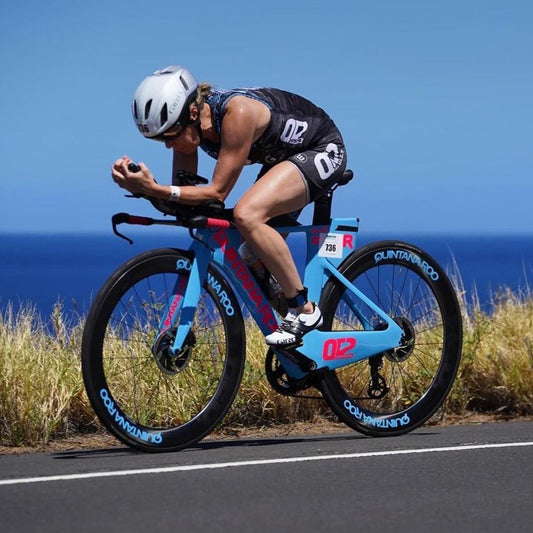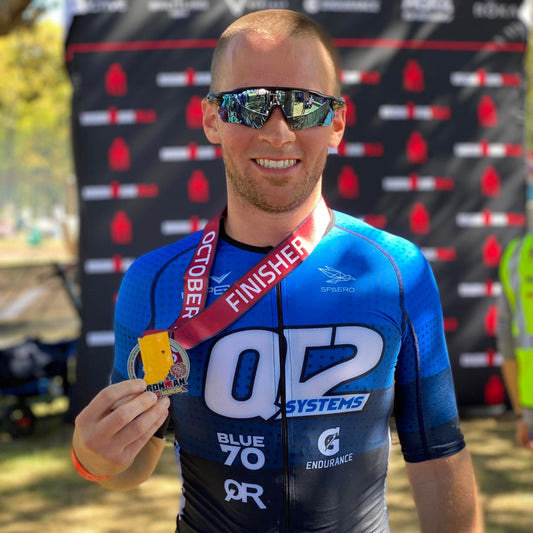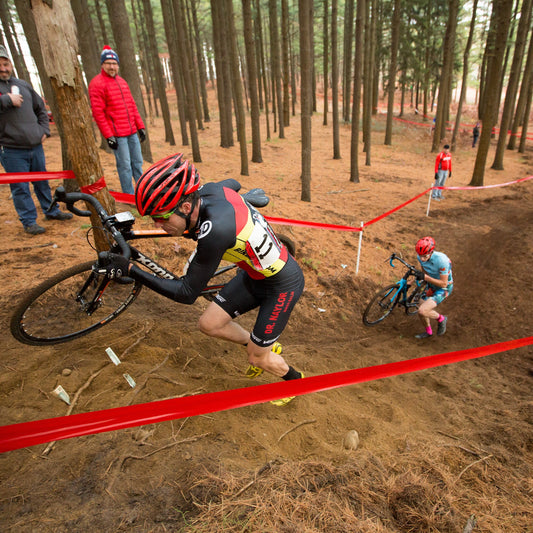The above presentation is best viewed on a computer.
You can access the presentation directly, HERE.
______________________
In the world of endurance coaching, the question "How can a coach measure if a training block is producing the desired adaptation?" sits at the heart of effective training prescription. The answer lies not in a single metric, but in a sophisticated understanding of how different training blocks create specific adaptations—and how to track those adaptations through targeted success metrics.
At QT2 Systems, we've developed a comprehensive framework for measuring training block effectiveness through our block periodization model. This system recognizes that each training block targets specific physiological systems and requires unique metrics to assess success. Rather than applying a one-size-fits-all approach, we match our measurement tools to the specific adaptations we're seeking to create.
The Foundation: Understanding Block-Specific Adaptations
Block periodization works because it targets one primary physiological system at a time, allowing for deeper adaptation without the interference effects that occur when trying to improve everything simultaneously. Each block in our system—Base/Durability, Build/TH, VO₂ Max, Specificity, and Rebuild/Reset—has distinct success metrics that align with its specific physiological and performance goals.
The key insight is that successful adaptation measurement requires three layers of assessment:
- Physiological Markers: Objective data showing system-specific improvements
- Performance Metrics: Functional improvements in race-relevant capacities
- Subjective Indicators: Athlete feedback and behavioral changes that signal adaptation
Base/Durability Block: Building the Foundation
The Base/Durability block serves as the foundation of athletic development, focusing on aerobic resilience, structural tolerance, and the ability to handle consistent training loads. This block is particularly crucial for athletes with low CTL, those returning from injury, or anyone needing to establish a robust training base before adding intensity.
Purpose and Physiological Focus
The Base/Durability block targets several key adaptations:
- Aerobic capacity expansion through mitochondrial density improvements
- Structural resilience via enhanced connective tissue strength
- Metabolic efficiency through improved fat oxidation capacity
- Training tolerance by building the ability to absorb consistent loads
Success Metrics for Base/Durability Blocks
Improved Fatigue Resistance
The hallmark of successful base building is enhanced fatigue resistance at sub-maximal intensities. We measure this through:
- Heart rate decoupling analysis: Power:HR or Pace:HR decoupling should remain below 5% during long aerobic efforts
- Pace/power stability: Athletes should maintain consistent outputs throughout extended sessions without significant drift
- RPE consistency: Perceived exertion should remain stable or decrease at given intensities over the course of the block
Stable Heart Rate at Sub-maximal Efforts
A well-executed Base/Durability block produces measurable improvements in cardiovascular efficiency:
- Cardiac drift reduction: Heart rate should remain stable during extended sub-maximal efforts
- Recovery heart rate: Faster return to baseline after moderate efforts
- Morning resting heart rate: Stable or slightly decreased resting HR indicating improved cardiac efficiency
Structural Adaptation Indicators
The structural component of base building is equally important and measurable:
- Training consistency: Ability to maintain planned training loads without injury or excessive fatigue
- Discipline-Specific CTL progression: Steady discipline-specific CTL growth, each week, without breakdown
- Subjective durability: Athletes report feeling stronger and more resilient in daily training
Load Absorption Capacity
Perhaps most importantly, successful base building enhances the athlete's ability to handle training stress:
- Discipline-Specific TSB stability: Training Stress Balance should remain in the productive negative range without excessive swings
- HRV trends: Heart Rate Variability should remain stable or show upward trends
- Sleep quality: Maintained or improved sleep patterns despite increased training loads
Common Pitfalls in Base/Durability Assessment
Coaches often make the mistake of rushing through base building or misinterpreting the metrics. Key warning signs include:
- Excessive Discipline-Specific TSB negativity: Consistently too low indicates poor load absorption
- Increasing HR decoupling: Worsening efficiency suggests accumulating fatigue
- Declining motivation: Mental fatigue often precedes physical breakdown
Build/TH Block: Raising the Aerobic Floor
The Build/TH block represents a critical transition from foundational fitness to performance-oriented training. This block focuses on raising Critical Power/Speed (CP/CS) and improving the athlete's ability to sustain race-relevant intensities.
Purpose and Physiological Focus
The Build/TH block targets:
- Critical Power/Speed improvement through enhanced lactate clearance
- Time-to-exhaustion extension at threshold intensities
- Metabolic efficiency at race-relevant efforts
- Muscular endurance for sustained moderate-high outputs
Success Metrics for Build/TH Blocks
Enhanced Power at Threshold
The primary marker of Build/TH success is improved sustainable power or pace:
- CP/CS progression: Regular testing should show steady improvements in Critical Power or Critical Speed
- CP:VO₂ Max ratio improvement: The ratio should progress toward 85-88% as threshold efficiency improves
- Functional Threshold Power/Pace: Improvements in the athlete's ability to hold and maintain longer duration efforts, such as 20-minute or 60-minute efforts
Better Metabolic Efficiency
Successful threshold development produces measurable efficiency gains:
- Lactate clearance: Improved ability to buffer and clear lactate at threshold intensities
- Respiratory exchange ratio: Better fat oxidation capacity at moderate intensities
- RPE reduction: Decreased perceived exertion at previously challenging threshold efforts
Improved Time-to-Exhaustion
A key indicator of successful threshold development:
- TTE testing: Athletes should demonstrate improved time-to-exhaustion at CP/CS
- Sustained effort capacity: Ability to maintain threshold efforts for progressively longer durations
- Interval quality: Maintenance of target power/pace throughout threshold interval sets
Workload Tolerance Improvements
Build/TH blocks should enhance the athlete's ability to handle threshold training:
- Session completion rates: Consistent ability to complete prescribed threshold work
- Recovery between sessions: Maintained quality across multiple threshold sessions per week
- Progressive overload tolerance: Ability to handle increasing threshold volumes or intensities
Training Stress Considerations
The Build/TH block requires careful monitoring of training stress accumulation:
- Discipline-Specific CTL progression: Aim to increase CTL week-over-week, but not at the expense of quality
- ATL management: Avoid excessive spikes in acute training load, so as to nurture an environment for workout quality
- TSB monitoring: Maintain productive fatigue levels without overreaching
VO₂ Max Block: Expanding the Aerobic Ceiling
The VO₂ Max Block represents the most physiologically demanding phase of training, targeting maximum aerobic capacity and high-intensity repeatability[4]. This block is reserved for athletes with solid aerobic foundations who need to expand their performance ceiling.
Purpose and Physiological Focus
The VO₂ Max Block drives:
- Maximum aerobic capacity expansion through central cardiovascular adaptations
- High-intensity repeatability via improved oxygen transport and utilization
- Neuromuscular power through enhanced recruitment patterns
- Central adaptations including stroke volume and oxygen carrying capacity
Success Metrics for VO₂ Max Blocks
Improved Power at VO₂ Max
The primary outcome of successful VO₂ Max training:
- Peak power/pace improvements: Higher outputs during maximal aerobic efforts
- 3-5 minute power progression: Measurable gains in sustained high-intensity efforts
- VO₂ Max testing: Direct measurement showing increased maximal oxygen uptake
Better Recovery Between High-Intensity Efforts
A crucial indicator of improved high-intensity capacity:
- Heart rate recovery: Faster return to target zones between intervals
- Power/pace maintenance: Ability to sustain target intensities across multiple intervals
- Lactate clearance: Improved buffering and removal of metabolic byproducts
Enhanced Repeatability at High Intensities
The functional outcome of improved VO₂ Max:
- Interval completion rates: Consistent ability to complete prescribed VO₂ Max sessions
- Power fade analysis: Minimal decrease in power/pace across interval sets
- Session tolerance: Maintained quality throughout high-intensity training blocks
Central Cardiovascular Adaptations
The underlying physiological improvements:
- Stroke volume: Increased cardiac output at maximal efforts
- Oxygen transport: Enhanced oxygen delivery to working muscles
- Capillary density: Improved oxygen extraction at the muscle level
Monitoring Considerations for VO₂ Max Blocks
Due to the high physiological cost of VO₂ Max training, careful monitoring is essential:
- HRV tracking: Heart Rate Variability often decreases during high-intensity blocks
- Sleep quality: Maintained sleep patterns despite high training stress
- Subjective readiness: Athletes should report adequate recovery between sessions
- Performance consistency: Ability to hit target intensities across multiple sessions
Recovery and Adaptation Balance
The VO₂ Max Block requires precise balance between stress and recovery:
- Polarized training distribution: Approximately 60% easy, 30% VO₂ Max, 10% recovery[4]
- Session frequency: Typically 2 high-intensity sessions per week maximum
- Block duration: Usually 2-4 weeks due to high physiological cost
Specificity Block: Converting Fitness to Performance
The Specificity Block represents the final phase of preparation, focusing on converting built fitness into race-ready performance through simulation and skill refinement[5].
Purpose and Performance Focus
The Specificity Block emphasizes:
- Race simulation under controlled conditions
- Pacing precision at race-specific intensities
- Fueling fluency with race-day nutrition protocols
- Technical execution under race-like fatigue
Success Metrics for Specificity Blocks
Improved Race Execution
The primary goal of specificity training:
- Pacing consistency: Ability to maintain target race pace without significant deviation
- Execution under fatigue: Maintained technique and decision-making as sessions progress
- Race simulation performance: Successful completion of race-distance efforts at target intensities
Confident Pacing
A crucial psychological and physiological adaptation:
- Internal pacing accuracy: Ability to hit target efforts without constant feedback
- Perceived exertion calibration: Accurate RPE assessment at race intensities
- Negative split capability: Ability to maintain or increase pace as efforts progress
Technical Skill Refinement
The movement quality component of race readiness:
- Biomechanical efficiency: Maintained form quality throughout race-duration efforts
- Transition skills: Smooth, efficient transitions between disciplines (for triathletes)
- Equipment familiarity: Comfort and efficiency with race-day gear and setup
Fueling and Hydration Mastery
The nutritional component of race execution:
- Gastrointestinal tolerance: Ability to consume planned race nutrition without distress
- Hydration maintenance: Proper fluid balance throughout race-duration efforts
- Energy stability: Consistent energy levels during extended race-pace efforts
Race-Specific Adaptation Indicators
Metabolic Efficiency at Race Pace
- Respiratory exchange ratio: Optimal fat/carbohydrate utilization at race intensities
- Heart rate stability: Consistent HR at race pace throughout extended efforts
- Lactate steady state: Stable lactate levels during race-pace efforts
Neuromuscular Readiness
- Cadence/stroke rate consistency: Maintained optimal movement patterns under fatigue
- Power/pace smoothness: Consistent output without significant fluctuations
- Fatigue resistance: Maintained efficiency late in race-simulation efforts
Psychological Preparation
- Confidence indicators: Athlete reports of readiness and race preparation
- Stress management: Ability to maintain composure during challenging sessions
- Race-day routine: Established and practiced pre-race and in-race protocols
Integration of Multiple Systems
The Specificity Block requires integration of all previously developed systems:
- Durability foundation: Ability to maintain race pace for race duration
- Threshold efficiency: Sustained power/pace at race intensities
- VO₂ Max capacity: Reserve capacity for race demands and surges
- Technical execution: Skill application under race-like conditions
Integrating Success Metrics Across Blocks
Progressive Development Model
Successful block periodization requires understanding how adaptations build upon each other:
- Base/Durability creates the foundation for all subsequent training
- Build/TH raises the sustainable performance floor
- VO₂ Max expands the performance ceiling
- Specificity converts fitness into race performance
Transition Indicators
Knowing when to progress from one block to the next:
- Base to Build: Stable CTL, clean HR decoupling, consistent training adherence
- Build to VO₂ Max: CP:VO₂ Max ratio >88%, strong threshold development
- VO₂ Max to Specificity: Improved ceiling capacity, race timeline considerations
- Any block to Rebuild: Declining performance, excessive fatigue, poor recovery
Long-term Monitoring
Successful coaches track adaptations across multiple blocks:
- Seasonal progression: Improvements in key metrics across training cycles
- Plateau identification: Recognition when current methods are no longer effective
- Limiter evolution: Understanding how athlete needs change with development
Practical Application for Coaches
Daily and Weekly Monitoring
Effective block assessment requires consistent data collection:
- Daily subjective measures: Sleep quality, energy levels, motivation
- Weekly objective testing: Heart rate variability, resting HR, body composition
- Session-specific metrics: Power/pace data, RPE, completion rates
Technology Integration
Modern coaches have access to sophisticated monitoring tools:
- TrainingPeaks analysis: TSS, CTL, ATL, TSB trending
- HRV monitoring: Daily readiness assessment
- Power/pace analysis: Detailed performance metrics
- Subjective tracking: Athlete-reported wellness data
Red Flags and Adjustments
Recognizing when adaptations aren't occurring:
- Stagnant metrics: No improvement in block-specific indicators
- Declining performance: Regression in key measures
- Poor recovery: Excessive fatigue, declining HRV
- Reduced motivation: Loss of training enthusiasm
Conclusion: The Art and Science of Adaptation Measurement
Measuring training block success requires a sophisticated understanding of how different training stimuli create specific adaptations. The most effective coaches understand that each block in the periodization model demands unique success metrics, and that these metrics must be viewed holistically rather than in isolation.
The Base/Durability Block builds the foundation through improved fatigue resistance and structural tolerance. The Build/TH Block raises the performance floor through enhanced threshold power and metabolic efficiency. The VO₂ Max Block expands the performance ceiling through improved maximum aerobic capacity and high-intensity repeatability. The Specificity Block converts fitness into performance through race simulation and technical refinement.
Success in block periodization comes from understanding that adaptation is not just about hitting numbers—it's about creating physiological changes that translate into improved race performance. The coach who masters the art of measuring these adaptations will be able to guide their athletes through systematic, progressive development that leads to breakthrough performances.
By matching our measurement tools to the specific adaptations we're seeking to create, we can ensure that every training block serves its intended purpose in the athlete's development journey. This precision in both prescription and assessment is what separates effective coaching from simply assigning workouts.
The question isn't whether the athlete is getting fitter—it's whether they're developing the specific adaptations that will make them faster, stronger, and more resilient on race day. That's the true measure of training block success.





